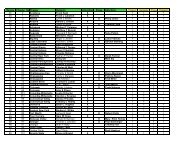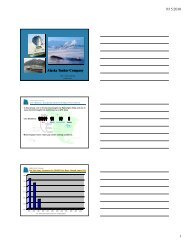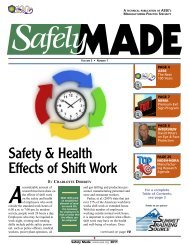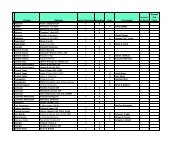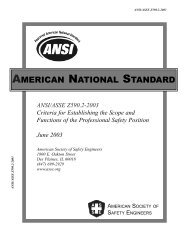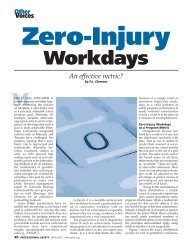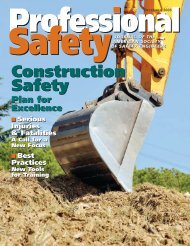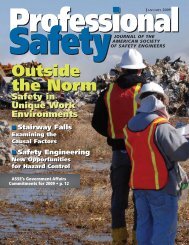Safety 2008 - ASSE - American Society of Safety Engineers
Safety 2008 - ASSE - American Society of Safety Engineers
Safety 2008 - ASSE - American Society of Safety Engineers
You also want an ePaper? Increase the reach of your titles
YUMPU automatically turns print PDFs into web optimized ePapers that Google loves.
Microscope workrequires forwardpostures <strong>of</strong> the headand arms. Viewingthrough a microscopefor prolongedperiods <strong>of</strong> time canfatigue the neckand shoulders.Headaches and eyefatigue are commonas well.bined with the awkward posture necessary to liftfrom floor level.Posture is another important consideration whenevaluating the ergonomic stressors and determiningthe level <strong>of</strong> risk. A minor deviation from normal posturemay not produce complaints, but an extremedeviation that is maintained for a prolonged timewould contribute to greater risk. Physical complaintsassociated with “inadequate working postures andoverloading are more likely to appear among thosewho are exposed to harmful postures for longer periods<strong>of</strong> time” (Ramos Vieira & Kumar, 2004, p. 154).Prolonged static posture is <strong>of</strong> concern because“during static effort the blood vessels are compressedby internal pressure on the muscle tissue, so thatblood no longer flows to the muscle” (Grandjean,1988, p. 7). In addition, poor overall body posture(e.g., slumping) contributes to ergonomic-relatedcomplaints. Risk increases further when force associatedwith lifting or carrying weight is combined withpoor body-segment posture. Repetitive motionsusing the same muscle groups (especially when combinedwith force) also heighten overall risk.Therefore, it is important to identify all ergonomicstressors that influence risk for a particular job. Forexample, lab employees may use a pinch grip (requiringforce between the thumb and index finger) to holda test tube against a vibratory mixer (vibration) forprolonged periods (static posture). To complicate matters,the shoulder may be elevated and the arm maybe held out from the shoulder with the elbow wingedout and wrist positioned in an awkward posture(ulnar deviation). In this case, after observing the taskand identifying the ergonomic stressors, the evaluatorshould ask whether the worker has any physical complaintswhen performing the task.Ergonomic Considerationsin the LaboratoryNeck PostureWorkstation design in the laboratory <strong>of</strong>ten leadsto awkward neck posture. For example, a worker26 PROFESSIONAL SAFETY AUGUST <strong>2008</strong> www.asse.orgmay be required to tilt his/her head forward toadapt to the work environment (Ramos Vieira &Kumar, 2004, p. 153). This is common when standingand looking down at an electrophoresis test, serologytest, petri dish, computer monitor or paperwork.Neck flexion (forward head tilt) requires the smallmuscles <strong>of</strong> the neck to hold the weight <strong>of</strong> the head,linking this posture with musculoskeletal symptoms<strong>of</strong> the neck and trapezius region. If this posture isobserved, one should determine the duration <strong>of</strong> thestatic flexion <strong>of</strong> the neck. If the posture is brief, itmay not be an issue; if exposure is prolonged, considerrepositioning the work or the worker.Standing PostureA worker’s overall back posture while standingshould also be assessed. Standing posture is commonin a lab because it enables a worker to cover alarge work area. This is actually ideal from anergonomics standpoint because movement is beneficial—musclesact as a blood pump when walking,promoting good circulation throughout the body(Grandjean, 1988, p. 7). Movement is so beneficialthat “standing in place should be imposed only for alimited period” (Kroemer, et al., 2001, p. 347).Work should be positioned at approximatelyelbow height. “Visual displays, including instruments,counters, dials and signals should be placedin front <strong>of</strong> the body and below eye level so that theline <strong>of</strong> sight (which aligns the eyes with the visualtarget) is declined 10° to 40° below the horizontallevel” (Plog, Niland & Quinlan, 1996, p. 377).If visual displays or laboratory charts (such asthose on equipment) are placed too high, the bodywill adjust to see better. Prolonged neck extension orneck flexion leads to postural fatigue and pain(Anshel, 1998, p. 42, 43). Posture should be evaluatedfor routine and nonroutine activities. Assess force(e.g., lifting) and duration requirements for awkwardpostures as well. Ensure that items used arewithin easy reach to prevent bending at the waist forprolonged periods. Many postural issues associatedwith a lab may be resolved with basic workstationadjustments.Sitting PostureLaboratory seating can present challenges associatedwith achieving optimum table and desk height.Chairs should be adjustable and should providelumbar support. Seat pans should have a waterfallfront and “be short enough that the front edge doesnot press into the sensitive tissues near the knee”(Kroemer, et al., 2001, p. 433).It is also important to provide clearance for theworker’s knees and thighs (Kroemer, et al., 2001,p. 348). The author has observed workers sitting inlaboratories twisted to the side or with both legsinside an open chemical cabinet door because therewas no room for their knees and thighs. A twistedbody posture is considered ergonomically unsuitable(Kroemer, et al., p. 346). Furthermore, placement<strong>of</strong> legs and feet inside a cabinet that containschemicals presents additional safety issues.



